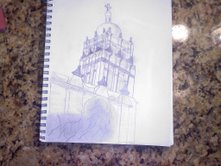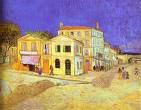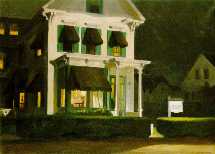perspective – The technique artists use to project an illusion of the three-dimensional world onto a two-dimensional surface. Perspective helps to create a sense of depth — of receding space. Fundamental techniques used to achieve perspective are: controlling variation between sizes of depicted subjects, overlapping some of them, and placing those that are on the depicted ground as lower when nearer and higher when deeper. In addition, there are three major types of perspective: aerial perspective, herringbone perspective, and linear perspective.
vanishing point – In linear perspective, a position on a horizon where lines or rays between near and distant places appear to converge (come together). In order to produce an illusion of depth in a two-dimensional representation of space, artists sometimes use one, two, or more vanishing points. Employing this method might seem to contradict a strictly mathematical understanding of space: parallel lines — as might form the edges of a straight path — meet at the vanishing point in a picture of a distant place, even though such lines could not meet in the actual distance. Although an artist marks vanishing points in pictures to determine the directions of receding lines, s/he is apt to remove them before completing a picture, because vanishing points are merely points of reference. Where would a vanishing point be placed in a drawing of this railroad scene?
______________
Resource Post 1

Artist: Vincent Van Gogh
Title: Café Terrace At Night
Dimension: 85 x 65.5cm
Media of each work: Oil on Canvas
Why you chose it: I chose this drawing because I think all of Van Gogh’s paintings are beautiful. I’ve always liked Van Gogh’s paintings due to his use of oil on canvas. I also liked his paintings because he usually draws a majority of his paintings at night time. I like all his night time drawings because I love how he draws the dark blue sky with the white stars. Above all, I think he showed a terrific example of a 1-point perspective.
What about the reference image you can integrate: He used wonderful colors of dark blue, and yellow. He drew the left side of the drawing beautifully with all of the citizens. He also did a great job drawing the second story of the café. He also drew the ally perfect with the 1-point perspective.
Some interesting factoid about the artist(s). Vincent Van Gogh lived in Paris with his family and his brother Vincent. Vincent only sold one painting in his entire lifetime, but become a very popular artist when he died. The first painting he drew was of poor people. In the beginning of his art career he drew many sad and dark drawings. In conclusion, Van Gogh lived a very sad life.
_______________
Resource Post 2

Artist: Rogier van der Weyden
Title: St. Luke Drawing the Virgin
Dimension: 137.5 x 110.8 cm
Media of each work: Oil and tempera on panel
Why you chose it: I chose this because it is a very religious drawing. This drawing resembles the beauty of Mary The Virgin holding baby Jesus and Gabriel the angel in the background. I also chose this painting because this drawing looks extremely realistic.
What about the reference image you can integrate: The artist did a wonderful job exemplifying 1-point perspective. He exemplified this by drawing the view of the town/village through the window behind Mary. He also used good patterns drawing the tiles on the floor.
Some interesting factoid about the artist(s). Roger van der Weyden was born in 1400 and died in 1464. He was also know as Roger de la Pasture. He became a City Painter for the city of Brussels in 1436. He biggest masterpiece was Descent From the Past.
_______________
Resource Post 3

Artist: Claude Monet
Title: La Rue de La Bavolle at Honfleur
Dimension: 100 x 100cm
Media of each work: Oil on canvas
Why you chose it: I chose this drawing because I don’t think Claude Monet is very noticed for his beautiful art. This drawing is beautiful in many ways. The way how the sun hits the town in a perfect way to light up the ally and the buildings and especially how the sky is a beautiful blue.
What about the reference image you can integrate: He used the color yellow and orange for most of the drawing. He used it for the street, buildings, and the girls clothing. He also used a form of 1-point perspective by drawing the ally of the town, layering the buildings on top of each other.
Some interesting factoid about the artist(s). Claude Monet was born in Paris in 1840. He died at the age of 86. As an artist he helped create the type of drawing called Impressionism. He spent most of his life drawing pictures of his teachers. He spent his last 10 years of his life painting his water graden.





























